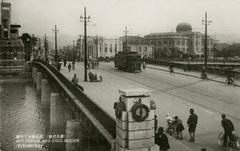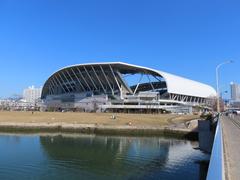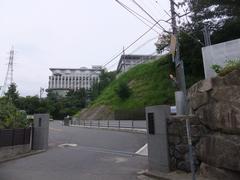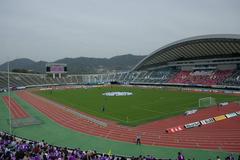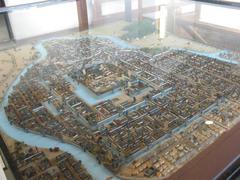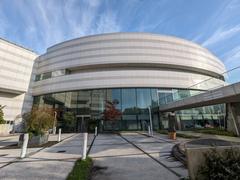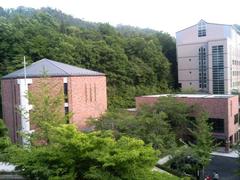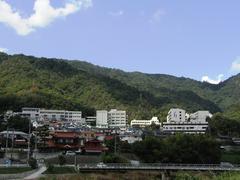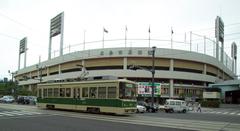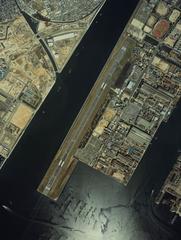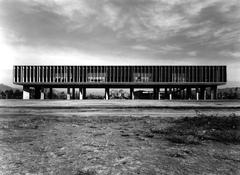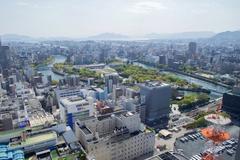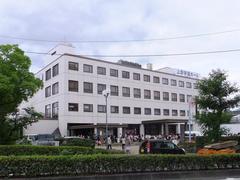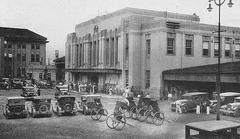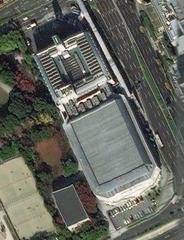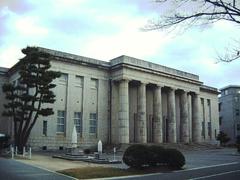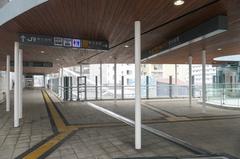
Honkawa Public Lavatory Hiroshima: Visiting Hours, Tickets, and Tourist Guide
Date: 04/07/2025
Introduction
The Honkawa Public Lavatory stands as an understated yet powerful symbol of Hiroshima’s resilience and commitment to peace. Located only a short distance from the atomic bomb hypocenter, this historic facility not only survived the devastation of August 6, 1945, but continues to serve residents and visitors alike. Its existence offers a tangible link to both the city’s pre-war modernization and its remarkable post-war recovery.
This detailed guide provides up-to-date information on Honkawa Public Lavatory visiting hours, accessibility, historical significance, and practical travel tips. Whether you are a history enthusiast, peace advocate, or a traveler seeking a meaningful itinerary, this article will help you make the most of your visit to this unique landmark and its surrounding Hiroshima historical sites.
(Hiroshima Peace Memorial Park Official Site)
(Hiroshima Tourism Official Website)
(Peace Tourism)
Table of Contents
- Historical Background of Honkawa District and the Public Lavatory
- The Atomic Bombing: Immediate Impact on Honkawa
- Architecture and Preservation
- Social and Cultural Importance
- Visitor Information
- Integration with Peace Education and Broader Initiatives
- Nearby Attractions and Photographic Spots
- Frequently Asked Questions (FAQ)
- Visuals and Media Resources
- Conclusion and Final Recommendations
- Official Sources and Further Reading
Historical Background of Honkawa District and the Public Lavatory
The Honkawa district, nestled along the Honkawa River in central Hiroshima, was a vibrant community before World War II, featuring residential neighborhoods, schools, civic spaces, and public amenities. Among these was the Honkawa Public Lavatory, constructed with reinforced concrete—an advanced material for its time and a testament to Hiroshima’s early 20th-century modernization efforts.
On August 6, 1945, the area was one of the closest to the atomic bomb’s hypocenter, suffering catastrophic destruction (history.co.uk). Remarkably, the Honkawa Public Lavatory survived, providing a rare, tangible connection to Hiroshima’s wartime past and the immediate aftermath. Its continued operation plays a subtle but important role in the city’s narrative of recovery.
Architecture and Preservation
The Honkawa Public Lavatory’s design reflects the practical modernism of post-war Japan. Its reinforced concrete structure, clean lines, and modest footprint represent the city’s focus on durability, functionality, and rapid reconstruction after the atomic bombing. While not as architecturally celebrated as nearby landmarks, its resilience and integration into the urban landscape reinforce its historical significance.
Preservation and maintenance are overseen by Hiroshima City, ensuring that the lavatory remains clean, safe, and accessible for all. Regular upkeep aligns with the standards expected of public facilities within areas of deep historical and cultural importance (Hiroshima’s Path to Reconstruction).
Social and Cultural Importance
Public restrooms in Japan are emblematic of the nation’s commitment to cleanliness, accessibility, and hospitality (omotenashi). In Hiroshima, this ethos is heightened by the city’s identity as a center for peace and remembrance. The Honkawa Public Lavatory, serving both residents and millions of visitors annually, exemplifies the integration of dignity and inclusivity into daily life, even in spaces as ordinary as public toilets.
Its proximity to the Hiroshima Peace Memorial Park and Honkawa Elementary School Peace Museum connects it with a landscape dedicated to peace, reflection, and education (Hiroshima Peace Memorial Park Tours). The lavatory’s unobtrusive design ensures that it supports, rather than distracts from, the solemn atmosphere of these memorials.
Visitor Information
Visiting Hours and Admission
- Standard Hours: Open daily, typically from 7:00 AM to 9:00 PM.
- Admission: Free of charge; no tickets required.
Hours may occasionally vary due to maintenance or special events. For the most reliable information, consult official tourism resources or inquire locally upon arrival.
Location and Access
- Address: Near Honkawa Elementary School, 1-5-39 Honkawa-cho, Naka-ku, Hiroshima City
- By Tram: Hiroden streetcar to Honkawa-cho stop, then a 5-minute walk
- Nearby Sites: Hiroshima Peace Memorial Park, Atomic Bomb Dome, Honkawa Elementary School Peace Museum
The facility is well signposted in both English and Japanese, and is easily reached on foot from the city’s main peace sites.
Facilities and Accessibility
- Separate sections for men and women
- Basic toilets (Japanese and Western styles)
- Running water for handwashing
- Modest signage (Japanese and some English)
- Accessibility: The original structure limits modern accessibility; there are no dedicated wheelchair-accessible stalls or advanced features. Alternative accessible restrooms are found in nearby parks and public buildings.
Etiquette and Visitor Tips
- Maintain a quiet, respectful demeanor
- Use provided bins for waste; do not litter or vandalize
- Exterior photography is permitted; interior photography is discouraged to protect privacy
- Carry tissues and hand sanitizer, as supplies may be limited
- Be mindful of the site’s solemn history when visiting
Integration with Peace Education and Broader Initiatives
The Honkawa Public Lavatory is often included in peace education programs for local students and international visitors. Its survival and continued use underscore the importance of dignity and accessibility in peacebuilding. The facility’s location near Honkawa Elementary School Peace Museum and the Peace Memorial Park anchors it within Hiroshima’s broader efforts to foster reflection and teach the lessons of history.
Events such as the August 6th anniversary of the atomic bombing often see increased visitor flow, and the lavatory supports these commemorations by providing essential services to participants and tourists (pcf.city.hiroshima.jp).
Nearby Attractions and Photographic Spots
- Hiroshima Peace Memorial Park: Genbaku Dome, Children’s Peace Monument, and more (Hiroshima Peace Memorial Park Tours)
- Honkawa Elementary School Peace Museum: Preserved A-bombed building with exhibits (Honkawa Elementary School Peace Museum)
- Hiroshima Castle: A short walk away; insight into the city’s feudal heritage (Explore City Life)
- Orizuru Tower: Offers panoramic city views and peace-related exhibits (Orizuru Tower Special Exhibits)
The Honkawa Public Lavatory’s exterior, set against the Honkawa River, is a unique subject for photography—symbolizing survival, reflection, and the quiet dignity of everyday spaces.
Frequently Asked Questions (FAQ)
Q: What are the Honkawa Public Lavatory visiting hours?
A: Open daily from 7:00 AM to 9:00 PM. Hours may vary during events or maintenance.
Q: Is there an admission fee or ticket required?
A: No, use of the facility is free.
Q: Is it accessible for people with disabilities?
A: Accessibility is limited due to the pre-war design. Nearby public buildings offer modern accessible restrooms.
Q: Can I take photos?
A: Exterior photography is allowed; please refrain from photographing inside the restroom.
Q: Are guided tours available?
A: The lavatory is sometimes included in broader peace and history tours, but not typically as a standalone destination.
Visuals and Media Resources
- High-quality images and virtual tours are available from official tourism websites (Hiroshima Tourism Official Website)
- Use descriptive alt text for photos, such as “Honkawa Public Lavatory Hiroshima historical site”
- Interactive maps of Hiroshima’s historical district can aid navigation
Conclusion and Final Recommendations
The Honkawa Public Lavatory is a subtle yet significant symbol of Hiroshima’s enduring spirit and dedication to peace. By combining practical use with historical remembrance, it highlights how everyday infrastructure contributes to the city’s legacy. Visitors are encouraged to approach the site with respect, integrate their visit into a broader exploration of Hiroshima’s historical sites, and use available resources for the most informed and meaningful experience.
For further travel tips and updates, consult official sources, join guided walks, and consider downloading the Audiala app for interactive maps, visitor tips, and the latest information on Hiroshima historical sites.
Official Sources and Further Reading
- Hiroshima Peace Memorial Park Official Site
- Hiroshima Tourism Official Website
- Peace Tourism
- Honkawa Elementary School Peace Museum
- Hiroshima Peace Memorial Park Tours
- Hiroshima as a Symbol of Resilience
- History.co.uk
- Historyonthenet.com
- Here There & Gone
- World History Journal
- Explore City Life
- ArchDaily

